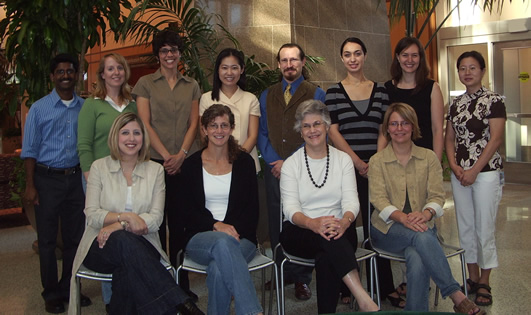|
|
 |
Back to Previous Page Previous Page
Laryngeal and Speech Section

Christy Ludlow, Ph.D., Senior Investigator
Dr. Ludlow received a B.Sc. in physiological psychology and an M.Sc. in
speech-pathology and audiology from McGill University. After completing her clinical training, she received her Ph.D. in speech pathology and
psycholinguistics from New York University. Dr. Ludlow moved to the NINDS to initiate laboratory work in speech physiology and joined the NINCDS Intramural Research Program in 1985. Dr. Ludlow received Honors of the American Speech-Language-Hearing Association in 2005 and the 2006 Award of the American Laryngological Association. Dr. Ludlow's section is studying the neurological organization and control of laryngeal function in voice, speech and swallowing, the pathogenesis of idiopathic voice and speech disorders, and the effects of functional electrical and sensory stimulation in severe swallowing disorders.
Staff:

- Soo-Eun Chang, Ph.D., CCC-SLP, Research Fellow, 301-402-0482 changsoo@ninds.nih.gov
- Bethany R Knorr Chung, Ph.D., Postdoctoral Fellow, 301-402-1092 chungb@ninds.nih.gov
- Katie Dietrich-Burns, M.S., CCC-SLP, Research Speech Pathologist, 301-594-5193 dietrichburnsk@ninds.nih.gov
- Xin Feng, M.D., Ph.D., Visiting Fellow, 301-496-9367 fengxi@ninds.nih.gov
- Victor Henriquez, Ph.D., Postdoctoral Fellow, 301-402-0482 henriquv@ninds.nih.gov
- Pamela Kearney, M.D., Staff Clinician, 301-402-0157 kearneyP@ninds.nih.gov
- Soren Y. Lowell, Ph.D., Postdoctoral Fellow, 301-402-5891 lowells@ninds.nih.gov
- Sandra B. Martin, M.S., CCC-SLP, Speech Pathologist, 301-402-1109 martinsa@ninds.nih.gov
- Binoy Mathews, M.S., Biomedical Engineer, 301-402-1496 mathewsbi@ninds.nih.gov
- Risa Schecter, Patient Coordinator, 301-496-9365 schecterr@ninds.nih.gov
- Kristina Simonyan, M.D., Ph.D., Research Fellow, 301-402-8129 simonyak@ninds.nih.gov
Research Interests:
The aim of the Laryngeal and Speech Section is to determine the pathogenesis of idiopathic voice and speech disorders, and to develop new treatment approaches for neurogenic voice, speech and swallowing disorders. Current projects include: 1. To determine the role of sensory function abnormalities in spasmodic dysphonia, laryngeal sensori-motor functioning is being evaluated in patients and controls using electromyography, afferent stimulation and magnetoencephalography. Basic studies are currently addressing the potential role of laryngeal inflammation in the development of laryngeal motor control disorders and the identification of sensori-motor pathways involved in laryngeal central nervous system control. 2. The feasibility of neuromuscular and sensory stimulation to improve swallowing in pharyngeal dysphagia is being studied. Hyolaryngeal movement and relaxation of the upper esophageal sphincter are being evaluated in patients with dysphagia to determine which muscle combination and stimulation timing is most effective for improving airway protection during swallowing. Experimental treatment studies for patients with chronic pharyngeal dysphagia involving both sensory and cortical stimulation are ongoing. 3. Families with familial spasmodic dysphonia and/or vocal tremor are being studied to determine the characteristics of this disorder and the pattern of inheritance. 4. Families with developmental phonological disorders or stuttering are being examined to compare risk factors for the pathogenesis of these complex developmental speech disorders. 5. Brain activation is being compared during speech production and perception using event related functional MRI in normal adults and patients with spasmodic dysphonia. Orthogonal contrasts compare brain activation differences between speech and non-speech perception and production during both imitation and encoding in persons who stutter. Studies will examine changes in brain activation during the critical period for speech disorders to determine which abnormalities are associated with chronic speech disorders.
 |  |
Clinical Protocols:
- Sensory Function in Idiopathic Voice Disorders 99-N-0009
- Brain Activation During Speech Production and Speech Perception 00-N-0095
- Functional Brain Mapping of Laryngeal Sensorimotor Control in Voice Disorders 03-N-0260
- Neuropathological basis of spasmodic dysphonia 05-N-0189
- Induciton of Volitional Swallowing in Chronic Dysphagia Post Stroke: a Novel Mechanism-Based Intervention 06-N00120
- Characteristics of Familial Speech Disorders 96-N-0088
- Characteristics of Familial Voice Disorders 96-N-0089
- Feasibility of Neuromuscular Stimulaiton for Laryngeal Elevation During Swallowing 99-N-0178
- The Effects of an NMDA-Receptor Antagonist in Idiopathic Voice Disorders 03-N-0119
- A Comparison of an Implanted Neuroprosthesis with Sensory Training for Improving Airway Protection in Chronic Dysphagia 06-N-0212
Selected Publications:
- Chang SE, Erickson KI, Ambrose NG, Hasegawa-Johnson MA, Ludlow CL (2008) Brain anatomy differences in childhood stuttering, Neuroimage 1;39(3), 1333-44. Full Text/Abstract
- Henriquez VM, Schulz GM, Bielamowicz S, Ludlow CL (2008) Laryngeal reflex responses are not modulated during human voice and respiratory tasks, J Physiol 15;585(Pt 3), 779-89.
- Ludlow CL, Hoit J, Kent R, Ramig LO, Shrivastav R, Strand E, Yorkston K,Sapienza CM (2008) Translating principles of neural plasticity into research on speech motor control recovery and rehabilitation, J Speech Lang Hear Res 51(1), S240-58. Full Text/Abstract
- Simonyan K, Tovar-Moll F, Ostuni J, Hallett M, Kalasinsky VF, Lewin-Smith MR,Rushing EJ, Vortmeyer AO, Ludlow CL (2008) Focal white matter changes in spasmodic dysphonia: a combined diffusion tensor imaging and neuropathological study, Brain 131(Pt 2), 447-59.
- Humbert IA, Poletto CJ, Saxon KG, Kearney PR, Ludlow CL (2008) The effect of surface electrical stimulation on vocal fold position, Laryngoscope 118(1), 14-9. Full Text/Abstract
- Loucks TM, Poletto CJ, Simonyan K, Reynolds CL, Ludlow CL (2007) Human brain activation during phonation and exhalation: common volitional control for two upper airway functions. , Neuroimage 36(1), 131-43. Full Text/Abstract
- Ludlow CL, Humbert I, Saxon K, Poletto C, Sonies B, Crujido L (2007) Effects of surface electrical stimulation both at rest and during swallowing in chronic pharyngeal Dysphagia, Dysphagia 22(1), 1-10. Full Text/Abstract
All Selected Publications
Contact Information:
Dr. Christy Ludlow
Laryngeal and Speech Section
Medical Neurology Branch, NINDS
Building 10, Room 5D38
10 Center Drive, MSC 1416
Bethesda, MD 20892-1416
Telephone: 301-496-9366 office,
301-496-9365 laboratory,
301-480-0803 fax
Email: ludlowc@ninds.nih.gov
|

